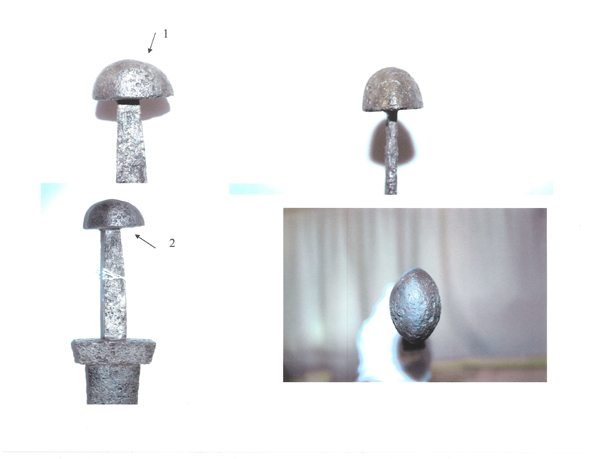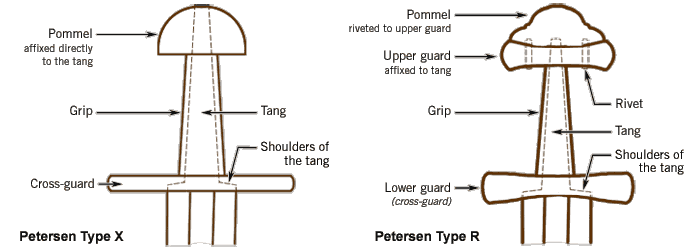| Author |
Message |
|
Steve Sarak
|
 Posted: Wed 23 Nov, 2005 4:33 pm Post subject: What do you think the grip looked like on this sword? Posted: Wed 23 Nov, 2005 4:33 pm Post subject: What do you think the grip looked like on this sword? |
 |
|
Hi, Iím having a copy made of this sword made but I canítí figure out what the grip looked like in its prime.
Iíve made a blue print of the sword and was surprised by the accuracy of it. There was only one spot that was off by .002 of an inch. So Iím a little perplexed by #2, the pommel is definitely off center and considering the accuracy of the rest of the sword, Iím led to believe that it was intentional.
Another question of the design is #1 you can see somewhat of a straight part on the pommel, now looking at it closely, there isnít much corrosion to explain it, also if it was caused by corrosion I wouldnít think it would corrode so evenly on both side.
So taking the pictures into account what do you think the grip originally looked like?
Iíd appreciate any input you have.
Thanks
Steve.
 Attachment: 83.81 KB Attachment: 83.81 KB

|
|
  |
 |
Nathan Robinson
myArmoury Admin


|
 Posted: Wed 23 Nov, 2005 4:48 pm Post subject: Posted: Wed 23 Nov, 2005 4:48 pm Post subject: |
 |
|
Is that pommel missing its lower portion? I can't tell by those photos, but they look like there might be a faint indication of rivet holes. I can't tell. There's something about it that doesn't quite look like a Petersen Type X or a Brazil-nut pommel. Again, I don't know.
Anyway. Finding swords with perfect symmetry might be a tougher task than finding those with even blatant symmetrical problems.

.:. Visit my Collection Gallery :: View my Reading List :: View my Wish List :: See Pages I Like :: Find me on Facebook .:.
|
|
    |
 |
|
Steve Sarak
|
 Posted: Wed 23 Nov, 2005 5:04 pm Post subject: Posted: Wed 23 Nov, 2005 5:04 pm Post subject: |
 |
|
I don't believe its missing anything, at close inspection it looks complete. also the grip is only 3.57 inches. not much room for anything.
Steve
|
|
  |
 |
Jean Thibodeau

|
 Posted: Wed 23 Nov, 2005 5:51 pm Post subject: Posted: Wed 23 Nov, 2005 5:51 pm Post subject: |
 |
|
Irregular symmetry seems to be something often seen in pictures of swords in my reference books and although some things could be blamed on corrosion or damage most of the irregularities just look as if it was because perfect symmetry was not the highest of priorities by the makers.
Time and age can't explain away a certain lumpiness of some pommels and the amount of corrosion wouldn't have selectively eaten away the pommel making an originally symmetrical pommel not so much !
In part I think our modern eyes are so used to geometric perfection that we are offended to think that an otherwise well made sword would have a sloppy, to us, geometry.
Now that some force or impact could twist pommel or guard out of position or bend it out of shape is possible but again some things would just have to have been made like we see them now.
And if A & A or Albion made a sword with these authentic irregularities there would certainly be people who would complain about sloppy work.
You can easily give up your freedom. You have to fight hard to get it back!
|
|
  |
 |
|
Patrick Kelly
|
 Posted: Wed 23 Nov, 2005 8:43 pm Post subject: Posted: Wed 23 Nov, 2005 8:43 pm Post subject: |
 |
|
It appears to be a "tea cosy" style of pommel. I believe that's the term Oakeshott used for it, but since I'm currently in a hotel room I don't have my books handy. It's a relative of the brazil nut style pommel and was common from the viking age into the early medieval period.
The flat portion looks as if it was made that way and is probably just part of the manufacturing process. asymmetries like this are quite common in originals.
I think a standard straight-sided grip would be best for this sword. Nothing fancy for an austere design like that.
"In valor there is hope.".................. Tacitus
|
|
   |
 |
|
Don Stanko
|
 Posted: Wed 23 Nov, 2005 9:17 pm Post subject: Posted: Wed 23 Nov, 2005 9:17 pm Post subject: |
 |
|
|
Hello, I know of one surviving example of a handle on a brazil nut pommel sword. The handle was covered in wood and wrapped in leather. The wrapping seems to be about 3/4 of an inch wide and wrapped several times around the handle. Suprisingly a good bit of the handle survived. Hope this helps.
|
|
  |
 |
|
Geoff Wood
|
 Posted: Wed 23 Nov, 2005 11:26 pm Post subject: pommel and tang Posted: Wed 23 Nov, 2005 11:26 pm Post subject: pommel and tang |
 |
|
Could the pommel have been placed off centre relative to the tang to compensate for the tang bending off slightly to one side, so that the pommel lined up better with the blade? If that was the case, they could have done a similar compensation with the grip. Tang looks to be bending to the left on my screen (or it might just be my old eyes).
Geoff
|
|
  |
 |
|
Don Stanko
|
 Posted: Thu 24 Nov, 2005 6:13 am Post subject: Posted: Thu 24 Nov, 2005 6:13 am Post subject: |
 |
|
|
Being an excavated piece, the bend may be from pressures in the ground deforming its shape. Its still a nice looking sword though.
|
|
  |
 |
|
Steve Sarak
|
 Posted: Sun 27 Nov, 2005 9:07 am Post subject: Posted: Sun 27 Nov, 2005 9:07 am Post subject: |
 |
|
Hi, Once again this site has been a great source of information.
apparently the pommel wasn't always a smooth round arch on the original swords of the time, but considering the exact dimensions of the rest of the sword, it seems that the smith would have kept the work up for the pommels as well.
So, a couple of questions come to mind. On other swords that have pommels with bad symmetry how close are the dimensions of the rest of the sword. Is it possible that the smiths created in parts, meaning that they might spend a couple of days creating pommels then a couple days creating cross guards etc. Then when it came to putting the swords together, they would have an inventory to pull from when they assembled the sword. that would explain why the rest of the sword is so accurate, like a said except for one part thats off by .002 the rest is virtually identical.
Second question is that the pommel is not centered, any one picking up the sword could see that its off, I would think that any smith would be more accurate then that, taking a little more pride in their work, it throws the look of the sword off. Unless they where in a hurry, lets say in a time of war, I would think, again considering the accuracy of the rest of the sword, that they would be more accurate on the centering of the pommel, why be so accurate on the other two parts and not that?
One last question, I know I might be getting a little off factual history with this one. If the sword was found without its pommel on it, most people that I've spoken to about it would lean to it being roman, but roman didn't use a round pommel. but all other swords that did use a round pommel didn't have that kind of cross guard (besides being short, it tapers inwards at the sides, and tapers inwards from the top to bottom in the front and back) so, if to quote someone else, this is a missing link sword, a cross between the end of one style and the begging of the next, that might explain the pommel being off center by so much, it might match a different grip other then simple wrapped in leather. so if we take that leap, what kind of grip would match the pommel being off center?
Since no one can find any reference to a sword of this kind, it might be time for a little imagination based on other swords of that period or maybe not. I know that thats not very accurate as far as creating a sword but without any point of reference other then other sword of the period thats all I have to go on. So go ahead, it you were a smith of the time and were creating a new design for a sword, encompassing two different style what kind of grip would you put on it, where the pommel would be so far off center?
Again I want to thank everyone out there that spends time thinking about and answering the question. Thats what makes the site so interesting even when not posting any question.
Steve
|
|
  |
 |
Addison C. de Lisle

|
 Posted: Sun 27 Nov, 2005 9:19 am Post subject: Posted: Sun 27 Nov, 2005 9:19 am Post subject: |
 |
|
It looks to me like a 'Viking' sword from the crossguard shape and size, as well as te general shape of the pommel.
For example, the Albion Vinland:

Of course, I could be entirely wong. 
|
|
   |
 |
|
|

